A Private Tour today in North Norfolk. The weather was mixed – cool and windy at times, with some heavy showers, but we had a great day out and enjoyed the sunny intervals.
We met up at Titchwell and journeyed east along the coast to Holkham first. We parked at Lady Anne’s Drive and walked west on the inland side of the pines. We could hear birds singing, but they were mostly keeping low in the cooler conditions. A Sedge Warbler perched up nicely and a Whitethroat performed a little song flight before disappearing back into the undergrowth. We could hear little groups of tits up in the pine trees, together with Goldcrests and Treecreepers but they were hard to see high up in the trees.
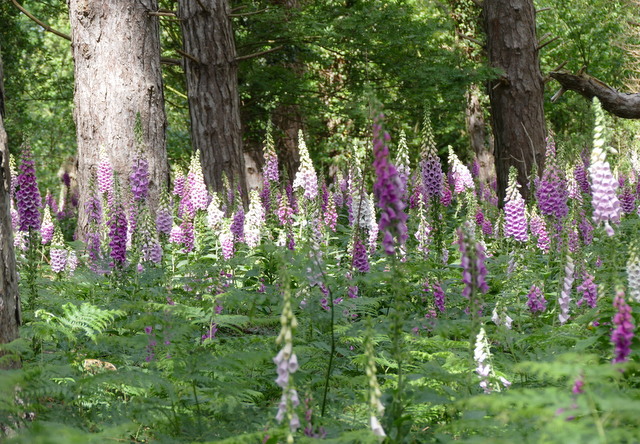 Foxgloves – looking beautiful in the dappled sunshine through the pines
Foxgloves – looking beautiful in the dappled sunshine through the pines
There were fewer birds on the pool from the Joe Jordan hide this morning, apart from a pair of Shelducks with ten shelducklings. There were no Spoonbills down on the pool today, perhaps keeping to the trees in the windy conditions. We could just see the top of a white head poking out from the trees. Several of the juveniles have already started to disperse along the coast with their parents in the last few days, but hopefully their are still more to come. The Cormorants appear to be doing well, with lots of well grown juveniles in the nests among the trees. A big flock of Avocets and Black-tailed Godwits was swirling round over the pools periodically.
There were lots of geese out on the grazing marshes as usual. Mostly they were feral Greylag Geese. A pair of Egyptian Geese flew in and landed on the grass. Then a darker head appeared from behind a grassy bank. A closer look through the scope confirmed that it had a smaller, darker bill that a Greylag Goose, with a narrow pink band around it. It was a Pink-footed Goose. Thousands of Pink-footed Geese come here for the winter, but most left already in February. Only a handful of presumably sick or injured birds remain through the summer.
The Marsh Harriers performed well, as ever. There were several birds whirling around the trees and quartering the grazing marshes. One bird dropped down out of sight into a ditch and came up with some dead wet reeds, presumably some additional material to enhance its nest – a bit of late home improvement! One of the resident female Marsh Harriers perched up on a dead tree where we could get a good look at her through the scope. She stood there for some time, presumably waiting for the male to return with food, though she eventually got impatient and flew off.
 Marsh Harrier – quartering the grazing marshes below us
Marsh Harrier – quartering the grazing marshes below us
We walked back along the path towards Washington Hide and took a diversion out along the boardwalk to look at the beach. As soon as we got out there, we could see dark clouds heading our way and we just managed to get back to the hide as the heavens opened. Thankfully the rain passed through very quickly. As soon as it brightened up, we headed back to the car. A Jay flew along the fence beside Lady Anne’s Drive, dropped down into the field and then landed on a fence post with a tasty morsel. It perched up nicely for us while it devoured whatever it had found there.
 Jav – perched up on a fence post feeding on an unidentified morsel
Jav – perched up on a fence post feeding on an unidentified morsel
We had been talking about orchids earlier in the day, so knowing of an amazing display of Marsh Orchids back along the coast we decided to make a quick change of itinerary and a short diversion. We walked through the dunes, stopping to admire the odd spike, before we came into a large dune slack and found the main attraction, a stunning purple carpet spread out across the grass.
 Marsh Orchids – a stunning carpet of flowers in the dunes
Marsh Orchids – a stunning carpet of flowers in the dunes
 Southern Marsh Orchids – most of the flowers were shades of regular purple
Southern Marsh Orchids – most of the flowers were shades of regular purple
The vast majority of the flowers were Southern Marsh Orchids, and mostly the regular form in a variety of shades of purple. However, there were also lots of white spikes obvious amongst them, the white-flowered albifrons variety of Southern Marsh Orchid, unusual to see in such profusion.
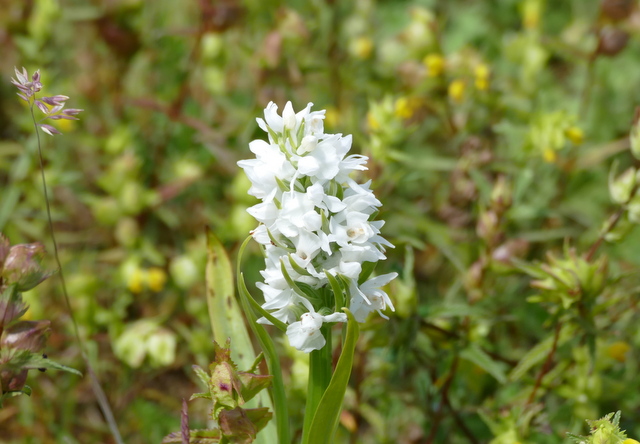 Southern Marsh Orchid var. albifrons – the white-flowered form
Southern Marsh Orchid var. albifrons – the white-flowered form
As we walked along the path through the orchids, we managed to pick out spikes of other species as well. There were quite a few Early Marsh Orchids of the sub-species coccinea, with deep red flowers, and some with slightly paler flowered spikes which may either be natural variation of intermediate forms. We also came across a few bright pink, conical flower spikes of Pyramidal Orchid, just starting to come into bloom. And here and there we found a few pale Common Spotted Orchid as well.
 Early Marsh Orchid – either subspecies coccinea or intermediate
Early Marsh Orchid – either subspecies coccinea or intermediate
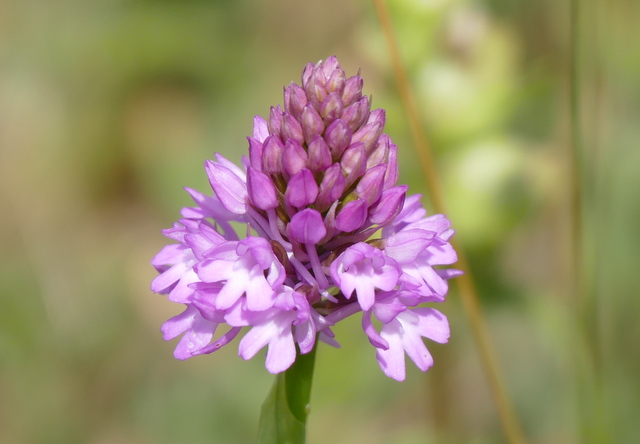 Pyramidal Orchid – just coming into bloom
Pyramidal Orchid – just coming into bloom
It was a real privilege to walk among such a beautiful display of orchids and well worth the diversion. We headed back to the car for lunch and we were just sitting outside enjoying the sunshine when another shower swept in on the breeze and saw us scurry for shelter inside, although it was very brief.
After lunch, we drove back to Titchwell and walked out onto the reserve. It was lovely weather out on the footpath at first, despite a brisk wind. The Reed Warblers were singing from down in the shelter of the reeds, and the Cetti’s Warblers shouting at us from the cover of the sallows, but a nice showy Sedge Warbler perched up on a bulrush.
 Sedge Warbler – singing from the top of a bulrush
Sedge Warbler – singing from the top of a bulrush
There were lots of Swifts zooming around low over the reeds, and a few House Martins in amongst them. Out on the reedbed pool, we stopped to admire several Red-crested Pochards, the males still sporting their bright orange punk haircuts, as well as a few Common Pochard and Tufted Duck. However, with the clouds darkening to the west, we made for the shelter of Island Hide, where it was nice to get out of the wind as well.
As usual, there were several Avocets in front of the hide – always nice to watch them feeding, sweeping their bills from side to side through the shallow water. We could also see lots of Black-tailed Godwits, mostly 1st summer Icelandic birds in a variety of different colours from grey-brown winter-like plumage to bright rusty-orange summer dress. Further over on the freshmarsh was a little group of paler Bar-tailed Godwits, mostly asleep, and with them a few smaller, dumpier grey Knot. A single black-bellied summer plumage Dunlin did its best to hide on one of the islands.
 Avocet – the obligatory Titchwell photo opportunity
Avocet – the obligatory Titchwell photo opportunity
The sky over the Parrinder Hide beyond gradually turned darker and eventually the rain swept in. It was a particularly impressive downpour and the freshmarsh appeared to empty as many of the birds seemed to seek shelter – most of the godwits flew off and the Avocets made for the reeds and islands. However, it was hard to even see across the freshmarsh for a minute or so!
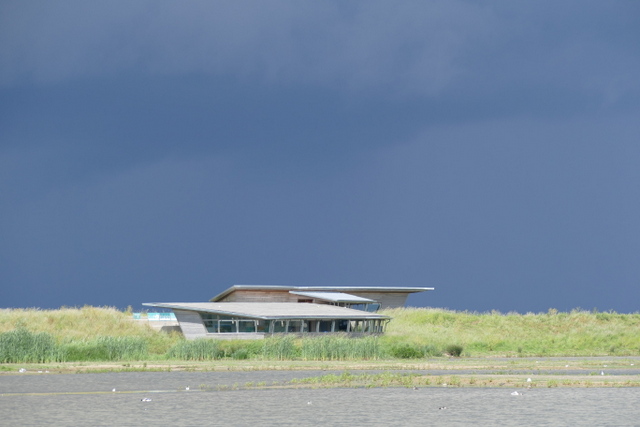 Parrinder Hide – with the sky blackening behind
Parrinder Hide – with the sky blackening behind
 Freshmarsh – appeared to empty as the heavy rain swept in
Freshmarsh – appeared to empty as the heavy rain swept in
 Avocets & Lapwing – sought shelter in the reeds
Avocets & Lapwing – sought shelter in the reeds
Thankfully, once again the rain passed through very quickly and it brought an unexpected bonus. There were two Spoonbill on one of the islands at the back of the freshmarsh before the rain, but they were up to their usual activity or lack thereof – fast asleep. After the worst of the rain had gone past, they woke up and walked out onto the water to preen. We finally got a chance to get a better look at them.
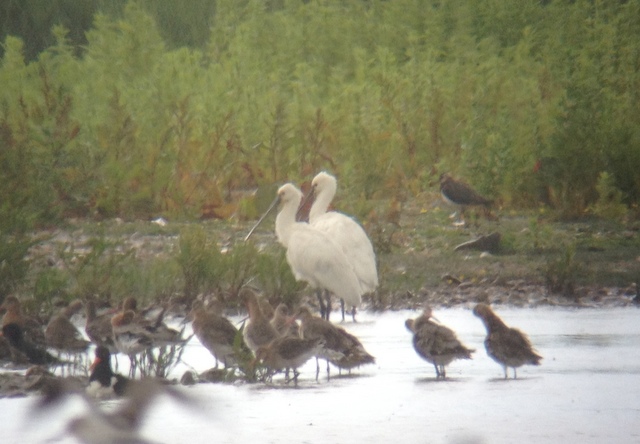 Spoonbills – finally woke up after the rain
Spoonbills – finally woke up after the rain
There were other birds to look out out on the freshmarsh as well. A variety of ducks, including lots of Gadwall, several large-billed Shoveler, and an increasing number of Teal already returning now. There have been a few Little Gulls around for several weeks and today was no exception, with at least three 1st summer birds feeding around the islands.
 Little Gull – one of the 1st summer birds still on the freshmarsh
Little Gull – one of the 1st summer birds still on the freshmarsh
As the skies brightened again and the rain stopped, we walked round to the Parrinder Hide. On the way, out on the saltmarsh, we could see a Chinese Water Deer feeding. This individual has been here for many months now and is distinguished by its increasingly tatty condition. As well as the bare patch on its back and ragged ears, it appeared to have something wrong with one of its eyes today, which was half-closed. Sad to see, but presumably there is little that can be done for it out here unfortunately.
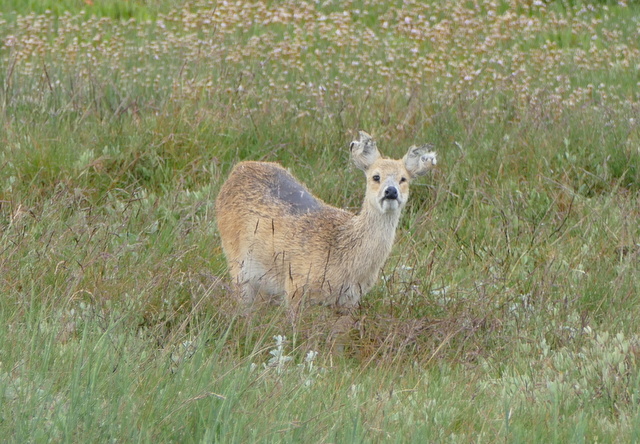 Chinese Water Deer – this individual looks in increasingly poor condition
Chinese Water Deer – this individual looks in increasingly poor condition
There was little new to be seen from Parrinder Hide, though we got closer views of many of the ducks from round here. A Snipe appeared from the vegetation and ran along one of the islands but disappeared back in again too quickly to get everyone on it and didn’t re-emerge. We had hoped to get a better look at the Spoonbills from here but having dried out a bit, they had obviously decided to fly off while we were on the path to the hide and couldn’t see them depart.
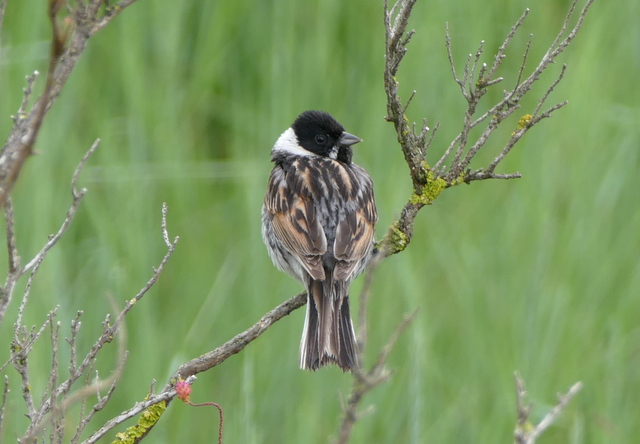 Reed Bunting – singing from a Suaeda bush
Reed Bunting – singing from a Suaeda bush
With more dark clouds gathering away in the distance to the west, we decided to make the best of the break in the weather and walk to the beach. A smart male Reed Bunting was singing from the Suaeda on the saltmarsh and a Little Egret on the tidal pools gave stunning close-up views.
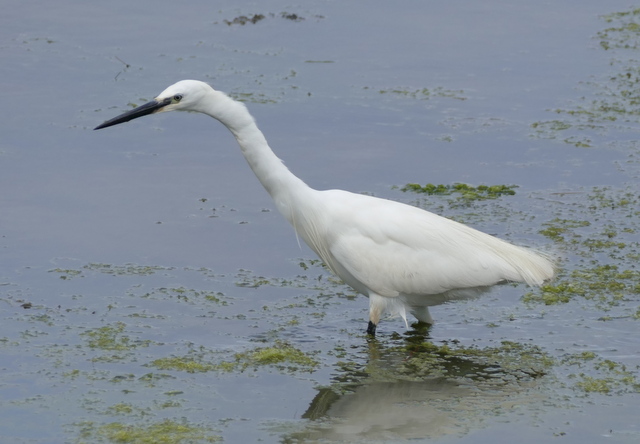 Little Egret – feeding stealthily on the tidal pools
Little Egret – feeding stealthily on the tidal pools
With the tide half way out, there were lots of Bar-tailed Godwits out on the rocks and a few Knot as well – possibly the birds which had been roosting on the freshmarsh earlier. A Ringed Plover was an addition to the day’s list, as was a Sandwich Tern fishing offshore. But with the threat of more rain and time running out with a train to catch, we walked quickly back.
There was still time for one more treat on our way. A Barn Owl was out hunting over the grazing meadow and we stopped to watch it circling round over the grass, occasionally stopping to hover or dropping suddenly into the vegetation. Always nice to see, and a great way to end the day.
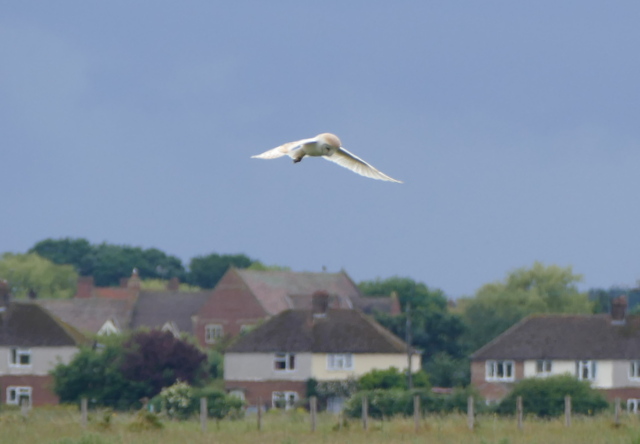
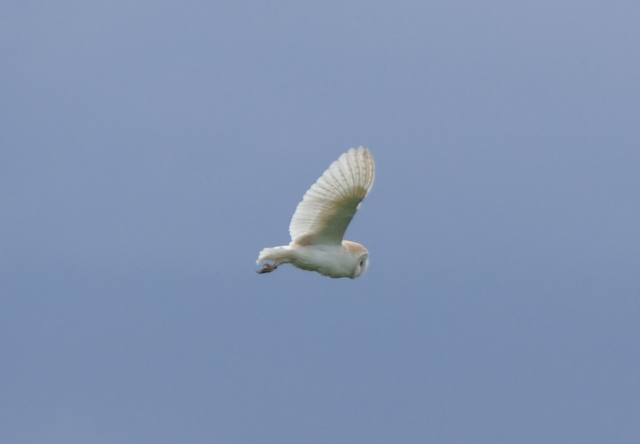 Barn Owl – out hunting over the grazing meadow this afternoon
Barn Owl – out hunting over the grazing meadow this afternoon
















